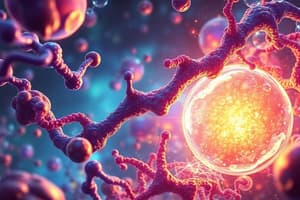Podcast
Questions and Answers
Which of the following statements about enzymes is true?
Which of the following statements about enzymes is true?
- Enzymes lower the activation energy required for reactions to proceed. (correct)
- Enzymes undergo a conformational change when substrates are not bound.
- Enzymes are not very specific in the reactions they catalyze.
- Enzymes permanently change their structure during reactions.
What is the function of cofactors in enzyme activity?
What is the function of cofactors in enzyme activity?
- To stabilize the transition state of the reaction. (correct)
- To bind to the active site of the enzyme.
- To regulate the enzyme's shape and reactivity.
- To permanently change the enzyme structure.
Which type of enzyme regulation occurs when a molecule binds to the enzyme at a location other than the active site?
Which type of enzyme regulation occurs when a molecule binds to the enzyme at a location other than the active site?
- Allosteric regulation (correct)
- Competitive inhibition
- Chemical modification
- Proteolytic cleavage
What limits the rate of catalysis in enzymes?
What limits the rate of catalysis in enzymes?
Which factor does NOT affect the rate of enzyme-catalyzed reactions?
Which factor does NOT affect the rate of enzyme-catalyzed reactions?
How can pharmaceuticals exploit enzymes?
How can pharmaceuticals exploit enzymes?
Which enzyme is targeted by Lipitor, a drug used to lower cholesterol levels?
Which enzyme is targeted by Lipitor, a drug used to lower cholesterol levels?
What type of enzymes are involved in breaking down cellulose?
What type of enzymes are involved in breaking down cellulose?
What is the purpose of modifying microbes' enzymes?
What is the purpose of modifying microbes' enzymes?
Which of the following is NOT a condition that affects enzyme function?
Which of the following is NOT a condition that affects enzyme function?
Which of the following best describes catalysis?
Which of the following best describes catalysis?
What is the role of enzymes in chemical reactions?
What is the role of enzymes in chemical reactions?
What determines the rate of a chemical reaction?
What determines the rate of a chemical reaction?
What is the function of enzymes in bringing reactants together?
What is the function of enzymes in bringing reactants together?
What is the role of enzymes in stabilizing transition states?
What is the role of enzymes in stabilizing transition states?
Which of the following is NOT a characteristic of enzymes?
Which of the following is NOT a characteristic of enzymes?
What is the relationship between activation energy and the energy barrier of a reaction?
What is the relationship between activation energy and the energy barrier of a reaction?
What condition needs to be reached for a reaction to occur?
What condition needs to be reached for a reaction to occur?
What is the function of a catalyst in a reaction?
What is the function of a catalyst in a reaction?
In the context of enzymes, what does the -ase ending indicate?
In the context of enzymes, what does the -ase ending indicate?
Flashcards are hidden until you start studying
Study Notes
Enzymes Overview
- Enzymes are biological catalysts that accelerate chemical reactions by lowering activation energy.
- The -ase suffix typically indicates a molecule is an enzyme.
Enzyme Activity and Cofactors
- Cofactors are non-protein molecules that assist in enzyme function by helping to stabilize the enzyme's structure or participate in the reaction.
- Examples of cofactors include metal ions like zinc, magnesium, and iron.
Enzyme Regulation
- Allosteric regulation occurs when a molecule binds to an enzyme at a site other than the active site, influencing enzymatic activity.
- This type of regulation can either enhance or inhibit enzyme function.
Catalysis and Reaction Rates
- The rate of catalysis in enzymes can be limited by substrate concentration, enzyme activity, temperature, and pH levels.
- Pharmaceuticals can exploit enzymes by inhibiting their activity or mimicking their function to treat various diseases.
Specific Enzyme Targets and Functions
- Lipitor targets the enzyme HMG-CoA reductase, which is crucial in the cholesterol synthesis pathway.
- Enzymes involved in breaking down cellulose are called cellulases.
Modifying Microbial Enzymes
- Modifying enzymes in microbes enhances their efficiency or stability, allowing for improved industrial applications like biofuel production.
Conditions Affecting Enzyme Function
- Temperature, pH, substrate concentration, and the presence of inhibitors or activators all affect enzyme activity.
- High temperatures can denature enzymes, while extreme pH levels can alter their active sites.
Characteristics and Role of Enzymes
- Enzymes are specific to their substrates and can speed up reactions without being consumed.
- They stabilize transition states, lowering the energy barrier for reactions to proceed.
Chemical Reaction Dynamics
- Activation energy represents the minimum energy needed for a reaction to occur, and it dictates the reaction rate.
- The function of a catalyst is to lower activation energy and increase the rate of a chemical reaction, allowing reactions to happen more efficiently.
Studying That Suits You
Use AI to generate personalized quizzes and flashcards to suit your learning preferences.



